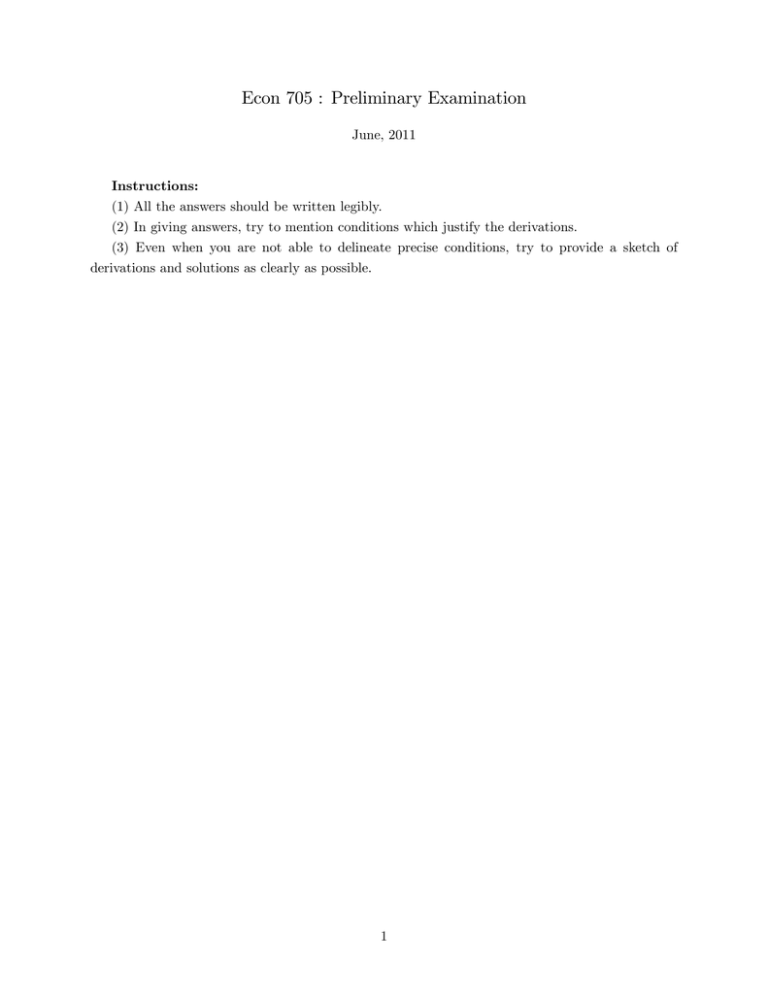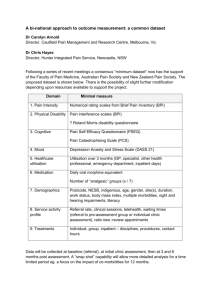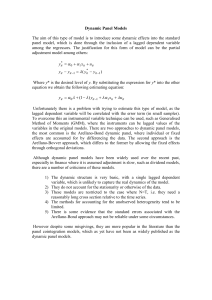Econ 705 : Preliminary Examination
advertisement

Econ 705 : Preliminary Examination June, 2011 Instructions: (1) All the answers should be written legibly. (2) In giving answers, try to mention conditions which justify the derivations. (3) Even when you are not able to delineate precise conditions, try to provide a sketch of derivations and solutions as clearly as possible. 1 (1)(a-d) (40 Points) Suppose that a researcher analyzes the labor supply of male workers in Pennsylvania. For t = 1; 2; let Yit represent the labor supply in log-hours of the i-th worker in year t, Xit be her nonlabor household log-income, and Mt denotes a macroeconomic shock that a¤ects the male worker’s labor supply. We assume that for each year t, the observations f(Yit ; Xit )gni=1 have been generated from the following regression models: Yit = 0 + Xit 1 + Mt 2 + uit , where uit denotes the unobserved variable a¤ecting Yit . For each t = 1; 2; the random vectors f(Yit ; Xit ; uit )gni=1 are i.i.d., and f(Yit ; Xit ; uit ) : t = 1; 2gni=1 are observed. Assume that V ar(X1t ) 2 (0; 1) for each t = 1; 2, E[u1t jfX1s ; Ms g2s=1 ] = 0 and E[u21t jfX1s ; Ms g2s=1 ] = (a)(10 Points) Suppose that Mt is not observed, and that one estimates Mt 2 2 > 0: 0 term omitted using the observations with t = 1. Is the estimator of and 1 1 using OLS with unbiased? Explain your answer. (b)(15 Points) Suppose that we are in the situation of (a). Is the estimator of 1 in (a) consistent and asymptotically normal? Explain your answer. (c)(15 Points) Suppose that one observes the macroeconomic shock Mt which is speci…ed as n 1X Mt = Dit ; n i=1 where Dit = 1 if the i-th worker is employed and 0 otherwise. It is assumed that for each t, f(Yit ; Xit ; Dit ; uit )gni=1 are i.i.d. Can one identify fMt ; Yit ; Xit ; Dit gni=1 0; at t = 1? Explain your answer. 2 1; and 2 separately using the observations (2)(a-e) (60 Points) Suppose that a researcher analyzes the employment status of female workers. Suppose that D1i is 1 if the i-th female worker is employed and 0 otherwise, and that D2i = 1 if the i-th female worker has at least one child and 0 otherwise. The variables D1i and D2i are speci…ed as follows: D1i = 1 f 0 + Xi 1 + D2i D2i = 1 f 0 + Xi 1 > ui g ; 2 > "i g and where the conditional distribution of "i given (Xi ; ui ) is a standard normal distribution, and the conditional distribution of ui given Xi follows a standard normal distribution. Let Xi denote the household income of the i-th female worker. The random vectors f(D1i ; D2i ; Xi ; D2i ; "i ; ui )gni=1 are i.i.d., and f(D1i ; D2i ; Xi )gni=1 are observed. (a)(10 Points) Provide conditions for the identi…cation of E[D1i jXi ] in terms of 0; 1, 2, 0; 1 and 2. (HINT: Write out and the standard normal CDF. In doing so, argue that D2i is independent of "i .) (b)(10 Points) (i) Provide three moment conditions that can be used to estimate (ii) Suppose that consistent estimators of 0; 1; and 2 0; 1, and 2 0; and 2. are given. De…ne GMM estimators of that use an optimal weighting matrix. (c)(10 Points) Provide conditions under which the estimators in (b)(ii) are consistent. (NOTE: Questions (d)-(e) are on the next page.) 3 1; (d)(15 Points)(i) Assume that we have estimators ^ 0 ; ^ 1 ; and ^ 2 of 0 , 1 , and 2 and estimators p ^ 0 and ^ 1 of 0 and 1 . Assume that these estimators are OP (1= n). Using these estimators, provide a consistent estimator of the interaction average derivative of P fD1i D2i = 1jXi = xg, i.e. E @P fD1i D2i = 1jXi = xg jx=Xi @x (HINT: Note that if D1i D2i = 1, D2i = 1:) (ii) Show that the estimator is consistent. (For simplicity of derivation, assume for this part (ii) p that 0 = 2 = 0 = ^ 0 = ^ 2 = ^ 0 = 0, and assume that ^ 1 and ^ 1 are OP (1= n).) (e)(15 Points) We are interested in testing nonpositivity of average derivative of D1i in D2i ; i.e., H0 : P [D1i = 1jD2i = 1] P [D1i = 1jD2i = 0] 0 against H1 : P [D1i = 1jD2i = 1] P [D1i = 1jD2i = 0] > 0: Provide a reasonable test statistic Tn and critical value c such that limn!1 P fTn > cg 0:05 under the null hypothesis. You need to show that the test indeed controls the size asymptotically. End of the Exam 4




